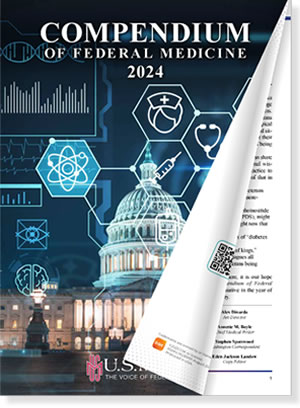PITTSBURGH — Daniel Hall, MD, MDiv, MHSc, noticed what many surgeons also have over the course of their careers: There was a small number of patients (5-10%) who, despite their surgeries going perfectly, experienced poor outcomes.
“We left the operating room feeling great, and with every expectation of a fine outcome,” explained Hall, a VA surgeon, researcher, and creator of the Surgical Pause Practice, which has been adopted nationally by VA. “But in post-op, some small amount of those folks did not do well. They lost their independence or became debilitated. They suffered complications that brought them back to the hospital.”
In short, some patients were too frail to fully benefit from surgery, and some ended up worse off than they were before. Hall knew this was happening because VA has been conducting post-operative analysis since the 1990s. Not being satisfied with identifying this cohort after the fact, he began to wonder if there was a way to identify them before they ever got on his table.
“If we could get a sense of those 5-10% of patients who were at disproportionately high risk for the worst outcomes, it would give us an opportunity to intervene and minimize those risks,” Hall said. “We recognize that you can’t make an 85-year-old frail patient robust. … They still may want to try for surgery, but it would allow us to set much more realistic expectations so that the patient and surgeon are not surprised.”
His solution was a brief, 14-item patient survey that takes about 30 seconds for a provider to administer. The survey evaluates the patient for things like strength, endurance, cognitive function, weight loss, appetite, medical comorbidities and activities of daily living.
“[Daily living] tends to be a very powerful predictor,” Hall said. “If you’re having difficulty with toileting yourself, bathing yourself, preparing your own meals, walking around, … taken together, you begin to see patients aren’t able to accomplish the sorts of things we expect as normal.”
The survey, known as the Risk Analysis Index (RAI), renders a score from 0-82. The higher the score, the more likely a patient will be to have an unfavorable outcome from surgery. Patients with a score 37 and above are generally considered frail.
The patients that score high on the RAI are not the ones described in the literature, Hall noted. They’re the ones whose age or comorbidities or general health systematically exclude them from the studies. However, a high score does not automatically mean surgery should be ruled out.
“There should not be a single thumbs-up, thumbs-down determination of who should have surgery,” he said.
Instead, a high score—and the act of giving the survey itself—can jolt the provider into looking at their patient with fresh eyes.
“We can get lulled into the habit of rapid algorithmic type thinking,” Hall admitted. “It can lull us into thinking that everything coming to the assembly line is a nail, and we’ve got a really good hammer. This makes us stop and pay attention.”
This also allows surgeons to bring other providers into the conversation: geriatricians, anesthesiologists and palliative care specialists, for example. With them, the surgeon can have a goal-clarification conversation with the patient, laying out the risks and benefits of surgery.
The initial implementation of the RAI was done in Omaha in 2012, and the results published in JAMA in 2017. The mortality among patients classified as frail dropped from 28% to less than 7%. It was later replicated at the Pittsburgh VA on a much bigger scale and showed an absolute drop of 4% in one-year mortality.
This broader practice of using the RAI and taking the time to evaluate a patient has been christened the Surgical Pause initiative and was nationally adopted by VA in 2023.
Making the RAI standard practice is only part of the shift that needs to happen for the Surgical Pause to be truly effective, Hall explained. Providers also need to train for the conversation with those patients who score high.
“When the conversation is handled well, [patients] respond very well to it,” Hall said. “A diagnosis of frailty can be stigmatizing to folks. [The survey] doesn’t use the word frailty, and most clinicians don’t label them with that diagnosis. Instead, what we are trying to do is train the clinicians and particularly the specialists who do the goal clarification to approach that conversation in a way that would frame things as, ‘We’ve looked carefully at all your other medical problems, and I’m worried that, no matter how we treat this, surgery could end up changing your life in some important ways.’ That’s enough of a signal for patients to take a step back.”
Being able to orchestrate this kind of conversation is not something usually taught in medical schools, especially to surgeons. That is slowly changing, Hall said. “People can teach how to make these communication exchanges high value. Some of the successes we’ve had relied on delivering those kinds of curriculum materials to the clinicians in the field.”
Hall is currently looking at ways to expand this predictive analysis farther into a patient’s recovery. VA has been conducting post-surgical analysis of veterans for decades, but those outcomes have mostly been limited to 30 days post-surgery. Newer data shows that about 5% of patients endure an unexpectedly long recovery time, the full extent of which can’t be seen unless you look a year out.
“We’re looking at ways to predict which people might have that kind of trajectory,” Hall said.
VA has also developed a version of the RAI that can be calculated using the diagnostic codes in the electronic health record. While the automated version has roughly the same predictive power as the manual survey, Hall is interested in testing whether it will have the same overall benefit for patients.
“Automating the score might make it easier to ignore,” Hall noted. “We’re going to see if part of the secret sauce is actually asking the clinician to spend those 30 seconds thinking about those 14 things.”


